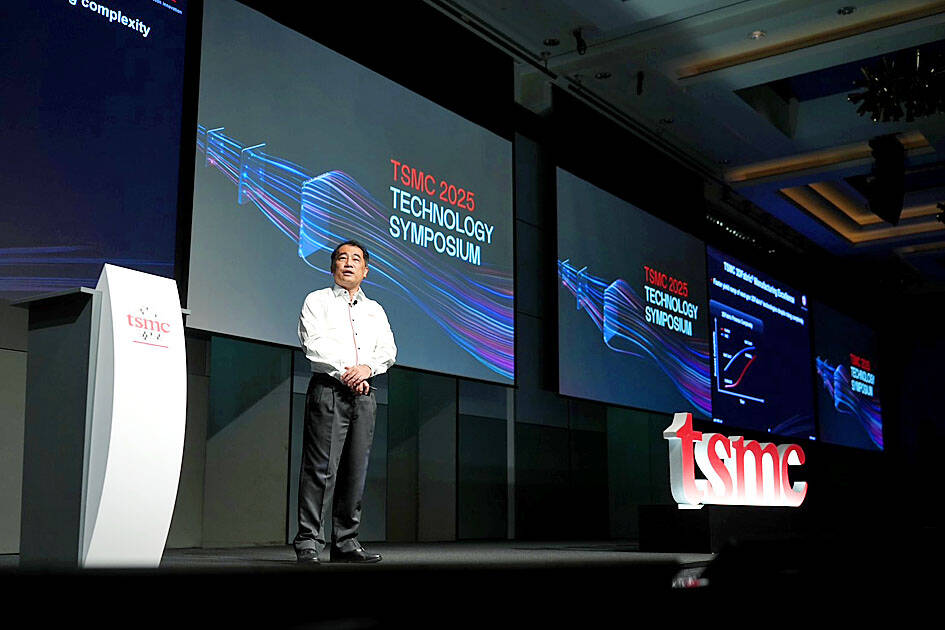Taiwan Semiconductor Manufacturing Co (TSMC, 台積電) yesterday said it is building nine new advanced wafer manufacturing and packaging factories this year, accelerating its expansion amid strong demand for high-performance computing (HPC) and artificial intelligence (AI) applications.
The chipmaker built on average five factories per year from 2021 to last year and three from 2017 to 2020, TSMC vice president of advanced technology and mask engineering T.S. Chang (張宗生) said at the company’s annual technology symposium in Hsinchu City.
“We are quickening our pace even faster in 2025. We plan to build nine new factories, including eight wafer fabrication plants and one advanced chip packaging factory,” Chang said. “To support customers’ business growth, we are expanding factories both in Taiwan and overseas.”

Photo courtesy of Taiwan Semiconductor Manufacturing Co
TSMC is slated to start construction of a new wafer fab, its most advanced, in Taichung by the end of this year, he said.
Dubbed Fab 25, the facility is to produce next-generation chips beyond 2-nanometer process technology, he said.
In Kaohsiung, TSMC plans to build five wafer fabs to produce chips using the 2-nanometer and A16 technology processes — with the latter its first angstrom-level technology — and next-generation advanced technologies, Chang said.
TSMC expects its 2-nanometer technology to enter volume production in the second half of this year at two new fabs in Hsinchu and Kaohsiung, he said.
In Arizona, TSMC is to start construction of a new manufacturing fab this year, while in Japan, the chipmaker plans to start building a second fab in Kumamoto Prefecture by the end of this year, he said.
In response to strong demand for HPC and AI chips, the company is to add one advanced chip packaging facility using chip-on-wafer-on-substrate (CoWoS) technology, Chang said.
TSMC expects to expand its CoWoS capacity at a compound annual growth rate of 80 percent from 2022 to next year, surpassing its previous estimate of 60 percent last year. The chipmaker experienced severe supply constraints of CoWoS capacity due to “insane” demand over the past two years.
TSMC last month said it planned to double its CoWoS capacity this year to further alleviate supply tightness.
“For the semiconductor industry, 2024 marked the first year of AI. The momentum is to carry into this year, driven by strong demand for AI data centers,” TSMC deputy cochief operating officer Kevin Zhang (張曉強) said.
That has led to robust demand for TSMC’s leading-edge technologies from 5-nanometer to 4-nanometer and for 3-nanometer technology, Zhang said.
TSMC expects to ship 60 percent more chips made with the 3-nanometer process this year compared with last year, bringing the compound annual growth rate to 20 percent from 2023 to this year.
The company’s shipments of overall AI chips would swell 12-fold this year from 2021, TSMC said.
It counts Nvidia Corp among its top customers for AI chips.
TSMC yesterday reiterated that total global semiconductor industry revenue would grow 10 percent annually this year, despite external uncertainty such as US tariffs.
“We have strong confidence about our projection last year that the world semiconductor market would grow to US$1 trillion in 2030,” Zhang said.
A large portion, about 45 percent of the semiconductor revenue, would derive from HPC devices, followed by smartphones’ 25 percent, automotive’s 15 percent and 10 percent from Internet-of-things, he said.
Although the automotive sector has been plagued by inventory-driven weakness over the past year or so, TSMC expects significant growth potential from the sector, thanks to faster adoption of more advanced technologies to cope with rising demand for advanced driver-assistance systems used in autonomous vehicles, Zhang said.
TSMC expects customers to adopt the firm’s 5-nanometer and 3-nanometer technologies, upgrading from 12-nanometer and 8-nanometer technologies, he said.

Taiwan is gearing up to celebrate the New Year at events across the country, headlined by the annual countdown and Taipei 101 fireworks display at midnight. Many of the events are to be livesteamed online. See below for lineups and links: Taipei Taipei’s New Year’s Party 2026 is to begin at 7pm and run until 1am, with the theme “Sailing to the Future.” South Korean girl group KARA is headlining the concert at Taipei City Hall Plaza, with additional performances by Amber An (安心亞), Nick Chou (周湯豪), hip-hop trio Nine One One (玖壹壹), Bii (畢書盡), girl group Genblue (幻藍小熊) and more. The festivities are to

Auckland rang in 2026 with a downtown fireworks display launched from New Zealand’s tallest structure, Sky Tower, making it the first major city to greet the new year at a celebration dampened by rain, while crowds in Taipei braved the elements to watch Taipei 101’s display. South Pacific countries are the first to bid farewell to 2025. Clocks struck midnight in Auckland, with a population of 1.7 million, 18 hours before the famous ball was to drop in New York’s Times Square. The five-minute display involved 3,500 fireworks launched from the 240m Sky Tower. Smaller community events were canceled across New Zealand’s

‘IRRESPONSIBLE’: Beijing’s constant disruption of the ‘status quo’ in the Taiwan Strait has damaged peace, stability and security in the Indo-Pacific region, MOFA said The Presidential Office yesterday condemned China’s launch of another military drill around Taiwan, saying such actions are a “unilateral provocation” that destabilizes regional peace and stability. China should immediately stop the irresponsible and provocative actions, Presidential Office spokeswoman Karen Kuo (郭雅慧) said, after the Chinese People’s Liberation Army (PLA) yesterday announced the start of a new round of joint exercises around Taiwan by the army, navy and air force, which it said were approaching “from different directions.” Code-named “Justice Mission 2025,” the exercises would be conducted in the Taiwan Strait and in areas north, southwest, southeast and east of Taiwan

UNDER WAY: The contract for advanced sensor systems would be fulfilled in Florida, and is expected to be completed by June 2031, the Pentagon said Lockheed Martin has been given a contract involving foreign military sales to Taiwan to meet what Washington calls “an urgent operational need” of Taiwan’s air force, the Pentagon said on Wednesday. The contract has a ceiling value of US$328.5 million, with US$157.3 million in foreign military sales funds obligated at the time of award, the Pentagon said in a statement. “This contract provides for the procurement and delivery of 55 Infrared Search and Track Legion Enhanced Sensor Pods, processors, pod containers and processor containers required to meet the urgent operational need of the Taiwan air force,” it said. The contract’s work would be